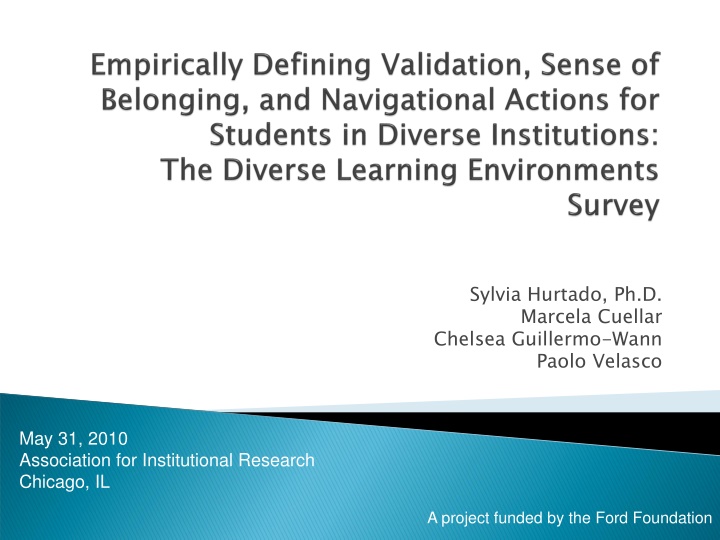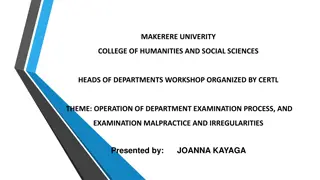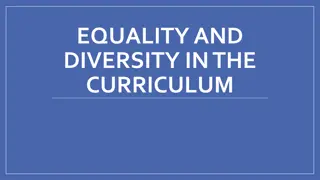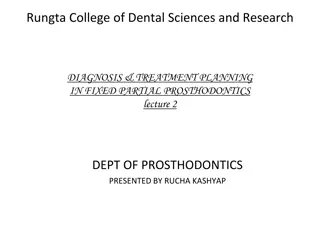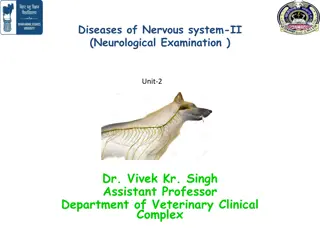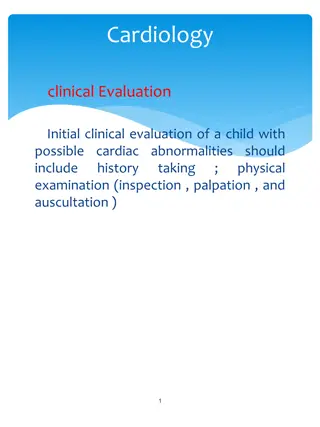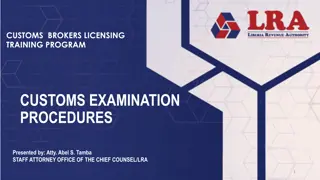Empirical Examination of Diversity in Learning Environments
This project, funded by the Ford Foundation, aims to establish constructs for examining relationships with student outcomes in diverse learning environments. It involves conducting surveys, validating constructs, advancing educator success with diverse students, and increasing retention rates. The research explores sense of belonging, navigational action, validation, and cognitive and affective elements in higher education settings.
Download Presentation

Please find below an Image/Link to download the presentation.
The content on the website is provided AS IS for your information and personal use only. It may not be sold, licensed, or shared on other websites without obtaining consent from the author.If you encounter any issues during the download, it is possible that the publisher has removed the file from their server.
You are allowed to download the files provided on this website for personal or commercial use, subject to the condition that they are used lawfully. All files are the property of their respective owners.
The content on the website is provided AS IS for your information and personal use only. It may not be sold, licensed, or shared on other websites without obtaining consent from the author.
E N D
Presentation Transcript
Sylvia Hurtado, Ph.D. Marcela Cuellar Chelsea Guillermo-Wann Paolo Velasco May 31, 2010 Association for Institutional Research Chicago, IL A project funded by the Ford Foundation
Empirically examine innovative and established constructs in the Diverse Learning Environments pilot survey (DLE) General validation Validation by faculty in the Classroom Sense of belonging Navigational action Goal: Establish constructs that can be used to empirically examine relationships with student outcomes
Assist educators in advancing the success of diverse students Assess undergraduate skills for work and citizenship in a pluralistic democracy Create the conditions for realizing the benefits of diversity in the learning process Increase retention rates and improve the assessment of retention
Research: Diverse Learning Environments Survey Campus Case Studies of 8 Institutions National Retention Study (Clearinghouse) Research: Practice: Institute for the Critical Analysis of Quantitative Data (July 13 15) Diversity Research Institute (August 4 6) Practice:
Sense of Belonging Validation Navigational Action & Capital
Comprises cognitive and affective elements Cognitive level: information about experiences with a group as a whole and other group members Affective level: feelings that reflect the individual s appraisal of their experiences with the group (Bollen & Hoyle, 1990) Original factor items I feel a sense of belonging to I feel that I am a member of the community I see myself as part of the community
Utilized in higher education research as a psychological sense of integration Illustrates the interplay between the individual and the institution (Hurtado & Carter, 1997) Original Bollen & Hoyle (1990) items modified to include broader concepts of cohesion DLE uses the original construct
Factors Influencing Sense of Belonging Perceptions of the campus climate for both white and students of color (Hurtado et al, 2007; Locks et al, 2008) Positive interactions with diverse peers (Locks et al, 2008) Different college predictors for different racial/ethnic groups Course-related faculty interaction, co-curricular involvement, and perceptions of supportive residential environments (Inkelas et al, 2007) Sense of Belonging Impacts Persistence (Hausmann et al, 2007)
Validation is an enabling, confirming and supportive process initiated by in- and out- of-class agents that foster academic and interpersonal development (Rend n, 1994) Differs from earlier theories on student persistence and learning (most notably Astin s Theory of Involvement)
Examples of invalidation Forms of validation Academic validation Interpersonal validation Occurs both in- and out-of-class Never empirically examined at a national level DLE includes measures of both general validation from faculty and staff and validation in the classroom
Qualitative research has examined validation Effects of validation on student experiences Feel capable of learning Experience a feeling of self worth Feel that they, and everything that they bring to the college experience, are accepted and recognized as valuable. Lacking validation, students feel crippled, silenced, subordinate, and/or mistrusted.
Navigation is critical for increasing academic goal attainment (AAC&U, 2002) Equip students with the necessary knowledge to make informed decisions about appropriate routes for their academic goals (AAC&U, 2002) Actions and requisite knowledge represent navigational capital (Yosso, 2005) Students of color must develop academic resilience that enables them to navigate social institutions (Alva, 1991, Yosso, 2005; see Solorzano, Ceja & Yosso, 2000)
Family & Community Support (Delgado Bernal, 2001; Sol rzano &Villapando, 1998) Peer & Faculty Support (Sol rzano, Ceja, &Yosso, 2000; Sol rzano & Delgado Bernal, 2001; Sol rzano & Villapando, 1998) Identifying Career Goals & Multiple Paths to It Having a Mentor Joining an Ethnic Organization DLE items measure navigational actions that demonstrate navigational capital at work Includes individual and community agency for students of color (Yosso, 2005)
Integrated assessment of climate, diversity practice, and outcomes Inclusive of diverse social identities Modules targeting specific topics Longitudinal when linked with other student data (e.g. other CIRP surveys, registrar data, etc.) Nationally available CIRP survey in Spring 2011
Core Survey Modules Classroom Climate Transition into the Major Intergroup Relations Community College Students Transfer Pathway Transition Experiences for Transfer Students at four-year Institutions
Online administration between January May 2010 14 institutions (9 represented in this analysis) 1 - community college (Midwest) 3 - four-year private institutions (West, Midwest, East) 5 - four-year public universities (West) Target sample: cohorts of second year and third year students Some institutions chose to sample additional cohorts
n = 3,306 undergraduate students Racial/ethnic demographics* Black 6% Asian American/Asian/Pacific Islander 19% Latina/o 19% White 68% Native American 6% Arab American/Arab 2% Other 2% Student characteristics 11% Frosh, 31% Soph, 32% Junior, 25% Senior 33% transfer and 9% re-entry students * Students could choose multiple categories
Structural Equation Modeling to conduct Confirmatory Factor Analysis Partial correlations Cross-tabulations
Items Items Factor Loadings .91 .95 Factor Loadings I see myself as part of the campus community I feel that I am a member of the campus community I feel a sense of belonging to my campus .81 Model Model- -Fit Results Fit Results .000 0 1.000 df NFI
Items Items Factor Loadings .50 .88 Factor Loadings Faculty empower me to learn here At least one staff member has taken interest in my development Faculty believe in my potential to succeed academically Staff encourage me to get involved in campus activities Staff recognize my achievements At least one faculty member has taken interest in my development .76 .49 .66 .89 Model Model- -Fit Results 458.7 Fit Results df 9 CFI .93
Items Items Factor Loadings .76 Factor Loadings Instructors were able to determine my level of understanding of course material Instructors provided me with feedback that helped judge my progress I feel like my contributions were valued in class Instructors encouraged me to meet with them after or outside of class Instructors encouraged me to ask questions and participate in discussions I received recognition for my work .81 .82 .64 .72 .72 Model Model- -Fit Results 390.23 Fit Results df 9 CFI .94
Factor Factor Sense of Belonging --- Sense of Belonging General Validation .57** General Validation Validation in the Classroom .37** Validation in the Classroom Sense of Belonging General Validation Validation in the Classroom .57** .37** --- .59** .59** --- p < .01
Validation General Validation Items Sense of Belonging .06*** --- .05** .05** --- .06*** Class Discussed career goals Attended professor s office hours Participated in study groups Creating a plan to achieve career goals Participated in faculty/mentor program Participated in the Ethnic or Cultural Center activities .08*** .06*** --- .04* .05** .04* .04* --- --- .07*** --- --- *** p < .001 ** p < .01 * p < .05
How often have you sought support from the following to successfully complete college? (5 pt Likert scale: never, seldom, sometimes, often, very often) Validation General Validation Items Sense of Belonging .08*** .08*** --- .08*** .09*** Class Upper class peers Peers in your same year Academic counselors Faculty Staff --- --- --- --- --- .23*** --- -.08*** .29*** .09*** *** p < .001 ** p < .01 * p < .05
Institutional Type Community College Four-year public Four-year private Institutional Type Low 10% Low Middle 69% Middle High 21% High 18% 9% 66% 68% 16% 23% = 62.85 p < .001
Institutional Type Community College Four-year public Four-year private Institutional Type Low 15% Low Middle 61% Middle High 24% High 20% 11% 66% 70% 14% 19% = 66.28 p < .001
Empirically identified useful constructs of validation to capture student experience Useful in revised conceptual models for retention and future research Student navigational actions are related to validation and sense of belonging, empowering students to learn
Seeking faculty support is key to increased general validation and within the classroom Staff are often left out of frameworks, however, preliminary research indicates they are important Frequent use of academic counselors appear to influence a lower sense of general validation Peer networks are central to sense of belonging
Final validation of these and other innovative DLE constructs Develop studies examining relationships between these constructs and key student outcomes, e.g. retention National launch of DLE survey through CIRP Spring 2011
Higher Education Research Institute http://www.heri.ucla.edu Diverse Learning Environments Project Website: http://heri.ucla.edu/dle Email: dleproject@gseis.ucla.edu Phone: 310-267-5930
